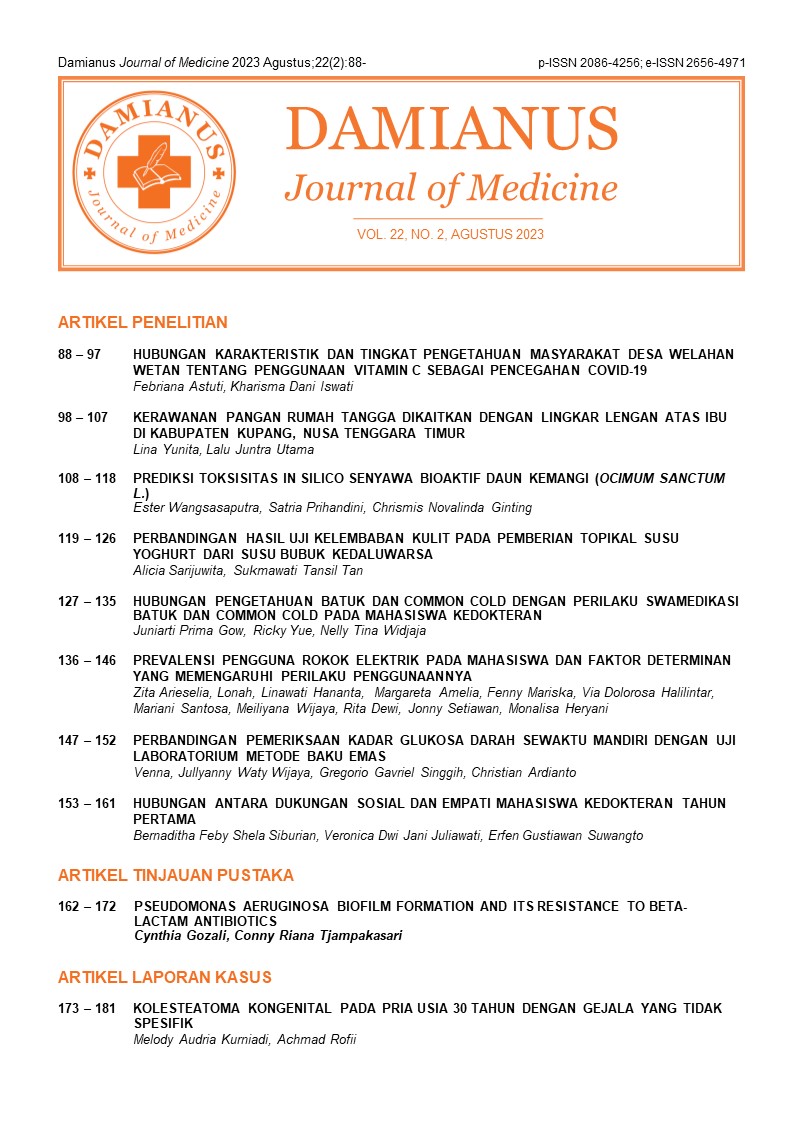Pseudomonas aeruginosa biofilm formation and its resistance to beta-lactam antibiotics
DOI:
https://doi.org/10.25170/djm.v22i2.3928Keywords:
biofilm, beta-lactam, Pseudomonas aeruginosa, resistanceAbstract
ABSTRACT
Introduction: An opportunistic pathogen, Pseudomonas aeruginosa is a Gram-negative bacteria that causes acute and chronic human infections. By adhering to appropriate surfaces and creating a biofilm matrix, Pseudomonas aeruginosa has a high-resistance structure. Due to biofilm resistance mechanisms, this bacterial biofilm may increase natural antibiotic resistance. Antibiotics have difficulty penetrating the exopolysaccharide matrix that makes up the biofilm structure (Psl, Pe, alginate, and eDNA). Alginate is involved in generating mucus, and Psl and Pel components are implicated in biofilm development and antibiotic resistance. Due to the connection between biofilm production and antibiotic resistance, Pseudomonas aeruginosa involves mechanisms of beta-lactam antibiotic resistance.
Objective: On this basis, learning more about the connection between Pseudomonas aeruginosa bacteria's ability to form biofilms and their resistance to beta-lactam antibiotics is essential.
Methods: We use literature methods from various literature on the biofilm formation of P. aeruginosa and its resistance to beta-lactam antibiotics, including research papers and studies with no restrictions types of studies included in this article.
Discussion: Pseudomonas aeruginosa has intrinsic and adaptive antibiotic resistance mechanisms. Decreased membrane permeability, the production of enzymes resistant to antibiotics, chromosomal changes, and horizontal gene transfer from other bacteria contribute to antimicrobial resistance. Beta-lactam antibiotic resistance mechanisms are known to be developed by Pseudomonas aeruginosa. The resistance characteristics of Pseudomonas aeruginosa may change phenotypically due to biofilm development. This article will be helpful in future research on Pseudomonas aeruginosa therapy and medication.
Downloads
References
2. Thi MTT, Wibowo D, Rehm BHA. Pseudomonas aeruginosa Biofilms. International Journal of Molecular Sciences. 2020; 21:8671.
3. Sarkar S, Dutta S, Namhata A, et al. Beta-lactamase Profile and Biofilm Production of Pseudomonas aeruginosa Isolated from a Tertiary Care Hospital in Kolkata, India. Journal of Clinical and Diagnostic Research. 2020; 14(10): 22-27.
4. Rocha AJ, Barsottini MRO, Rocha RR, et al. Pseudomonas aeruginosa: Virulence Factors and Antibiotics Resistance Genes. Brazilian Archives of Biology and Technology. 2019; 62: e19180503.
5. Pang Z, Raudonis R, Glick BR, et al. Antibiotic Resistance in Pseudomonas aeruginosa: Mechanism and Alternative Therapeutic Strategies. Biotechnology Advances. 2019; 37: 177-192.
6. Ciofu O, Nielsen TT. Tolerance and Resistance of Pseudomonas aeruginosa Biofilms to Antimicrobial Agents – How P. aeruginosa Can Escape Antibiotics. Front. Microbiol. 2019; 10:913.
7. Heydari S, Eftekhar F. Biofilm Formation and -lactamase Production in Burn Isolates of Pseudomonas aeruginosa. Jundishapur J Microbiol. 2015; 8(3):e15514.
8. Almanama AA, Al-Sheboul SA, Abu-Dan RI. Antimicrobial Resistance and Biofilm Formation of Pseudomonas aeruginosa: A Short Review Article. The International Arabic Journal of Antimicrobial Agents. 2020; 10(2): 1-11.
9. Sekhi RJ. Pseudomonas aeruginosa: A Review Article. European Scholar Journal. 2022; 3(3): 78-84.
10. Behzadi P, Barath Z, Gajdacs M. It’s Not Easy Being Green: A Narrative Review on The Microbiology, Virulence and Therapeutics Prospects of Multidrug-Resistant Pseudomonas aeruginosa. Antibiotics. 2021; 10(42): 1-29.
11. Tuon FF, Dantas LR, Suss PH, et al. Pathogenesis of The Pseudomonas aeruginosa Biofilm: A Review. Pathogens. 2022; 11(300): 1-9.
12. Jurado-Martin I, Sainz-Mejias M, McClean S. Pseudomonas aeruginosa: An Audacious Pathogen with An Adaptable Arsenal of Virulence Factors. International Journal of Molecular Sciences. 2021; 22(3128): 1-35.
13. Liao C, Huang X, Wang Q, et al. Virulence Factors of Pseudomonas aeruginosa and Antivirulence Strategies to Combat Its Drug Resistance. Front. Cell. Infect. Microbiol. 2022; 12:926758.
14. Vetrivel A, Ramasamy M, Vetrivel P, et al. Pseudomonas aeruginosa Biofilm Formation and Its Control. Biologics. 2021; 1: 312-336.
15. Rasamiravaka T, Labtani Q, Duez P, et al. The Formation of Biofilms by Pseudomonas aeruginosa: A Review of The Natural and Synthetic Compounds Interfering with Control Mechanisms. Biomed Research International. 2015; 759348: 1-17.
16. Das T, Manoharan A, Whiteley G, et al. Pseudomonas aeruginosa Biofilms and Infections: Roles of Extracellular Molecules. Elsevier; 2020.
17. Olivares E, Badel-Berchoux S, Provot C, et al. Clinical Impact of Antibiotic for The Treatment of Pseudomonas aeruginosa Biofilm Infections. Front. Microbiol. 2020; 10:2894.
18. Qin S, Xiao W, Zhou C, et al. Pseudomonas aeruginosa: Pathogenesis, Virulence Factors, Antibiotics Resistance, Interaction with Host, Technology Advances and Emerging Therapeutics. Signal Transduction and Targeted Therapy. 2022; 7:199.
19. Stewart PS. Mechanisms of Antibiotic Resistance in Bacterial Biofilms. Int. J. Med. Microbiol. 2002; 292: 107-113.
20. Yan J, Bassier BL. Surviving as A Community: Antibiotic Tolerance and Persistence in Bacterial Biofilms. Cell Host Microbe. 2019; 26(1): 15-21.
21. Ratajczak M, Kaminska D, et al. Relationship between Antibiotic Resistance, Biofilm Formation, Genes Coding Virulence Factors and Source of Origin of Pseudomonas aeruginosa Clinical Strains. Annals of Agricultural and Enviromental Medicine. 2021; 28(2): 306-313.
22. Alfei S, Schito AM. -lactam Antibiotics and -lactamase Enzymes Inhibitors, Part 2: Our Limited Resources. Pharmaceuticals. 2020; 15:476.
23. Lin H, Feng C, Zhu T, et al. Molecular Mechanism of The -lactamase Mediated -lactam Antibiotic Resistance of Pseudomonas aeruginosa Isolated from A Chinese Teaching Hospital. Front. Microbiol. 2022; 13:855961.
24. Glen KA, Lamont IL. -lactam Resistance in Pseudomonas aeruginosa: Current Status, Future Prospects. Pathogens. 2021; 10:1638.
25. Mousa R, El-Kady MF, Hussein AAA, et al. Occurrence of Carbapenem Multidrug-resistant Pseudomonas aeruginosa carrying blaVIM Metallo--lactamases and Their Biofilm Phenotypes in Al-Azhar University Hospital. Journal of Applied Pharmaceutical Sciences. 2022; 12(3): 73-81.
26. Sezadehghani A, Dehbashi S, Tahmasebi H, et al. Detection of blaOXA-145, blaOXA-224, blaOXA-539 and blaOXA-675 Genes and Carbapenem-Hydrolyzing Class D -lactamases (CHDLs) in Clinical Isolates of Pseudomonas aeruginosa Collected from West of Iran, Hamadan. International Journal of Microbiology. 2022; 3841161.
Downloads
Published
Issue
Section
License
Copyright (c) 2023 Damianus Journal of Medicine

This work is licensed under a Creative Commons Attribution-ShareAlike 4.0 International License.














